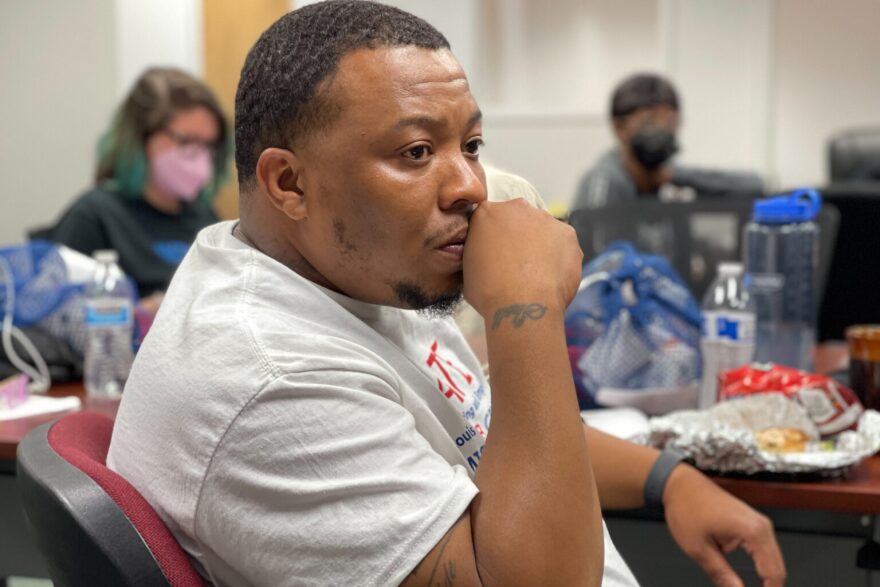On the night of April 24, 2013, six residents living in a neighborhood just north of downtown St. Louis say they saw the same thing.
A young Black man — 25-year-old Cary Ball Jr. — crashed his car, got out, stumbled onto another car and limped away. And then each said they saw Ball drop a gun from his hand and raise his arms to surrender.
That’s when they saw two police officers stand over Ball and shoot him repeatedly. Analysis of the evidence three years later by a Washington University professor concluded Ball was shot 25 times from within five feet range.
The police stated in their report that they feared for their lives because Ball pointed the gun at them. A police and F.B.I. investigation of the incident cleared the officers, and charges were never filed.
A year later, Michael Brown’s shooting death in Ferguson started a national movement calling for police accountability. Ball’s shooting barely registered with local or national media.
There was no blueprint for what Ball’s mother, Toni Taylor, or his younger brother, Carlos Ball, should do or who they could turn to.
“When my brother was killed, I wish it could have been an impacted family that reached back and grabbed us,” said Carlos Ball, who was 24 at the time. “But there wasn’t.”
Carlos Ball and his mother are now leaders in a group of largely grieving families who respond to officer-involved shooting scenes, called the Fatal State Violence Response Team, which was organized by the ArchCity Defenders nonprofit law firm.
At crime scenes, volunteer “crisis responders” ask the questions of witnesses and law enforcement that Ball’s family wish someone would have asked for them — including the names and badge numbers of the officers involved.
And they also try to support the families in every way they can.
“There’s no book that comes along with this fight,” Taylor said. “So what [Fatal State Violence] has done is basically provided a little structure of pamphlets and brochures to at least get the families in the right direction and be of assistance.”
The team also writes up reports and inputs information into databases that they can use for future analysis for the ArchCity’s overall Fatal State Violence project. The project’s January 2021 report found that from 2009 to 2019, at least 132 people have been killed by police in the St. Louis region.
Of those deaths, 72% of the people were Black.
The group uses the analysis to support their calls to action. And those calls have resulted in action by local government — including a June executive order from the mayor to end no-knock raids and legislation the mayor signed last week to create a civilian-led agency to investigate police misconduct.
The ordinance also directs Circuit Attorney Kim Gardner’s Office to lead use-of-force investigations that could end in criminal charges, investigations that are currently done by the police themselves.
The new law promises to be the first substantive victory for police accountability since Michael Brown’s death made St. Louis the epicenter of the most promising civil rights movement since the 1960s.
Tammy Bufford, a response team member and the mother of Cortez Bufford who was killed in 2019, stood by the mayor as she signed the bill.
“Today’s signing of Board Bill 47 into law is a long-awaited moment,” Bufford said at the Aug. 3 press conference, “and a step in the right direction towards holding officers accountable for their misconduct and wrongdoings.”
Crisis responders

The group first launched November 19, 2021, with nine volunteers — seven crisis responders and two hotline responders.
And in that first month, there were five officer-involved deaths – two of them involved car chases and three involved shootings. One day, Dec. 12, there were two in the same day in the neighboring municipalities of Jennings and Ferguson.
“We had people who were trying to respond to the first one when we found out about the second,” said Keith Rose, who was among the first group of volunteers along with Taylor.
In May, Rose helped train a second cohort of volunteers, who had to go through a “simulation training” held at the ArchCity Defenders’ Office.
Rose played the role of the police officer, charged with keeping people away from the crime scene which was an office room that was blocked off with yellow scene tape. Three people were assigned to be crisis responders, and others were journalists, livestreamers, store owners, family members or witnesses.
As the scene unfolded, everyone all flew into action.
Through the high emotions, yelling and crying, the crisis responders had to focus on observing and asking key questions. How many evidence markers were there? What are the names and badge numbers of the officers on the scene? What did witnesses see and hear?
After the exercise, Brittany Watkins, a staff attorney with ArchCity who facilitates the initiative, asked the responders how they were feeling.
“Overwhelmed” was the united answer.
“It was so chaotic,” said Kiya Williams, whose brother Dwight Williams died in custody at the city jail in 2020. “You kind of tend to forget or not notice certain things because a lot is going on. So this is most definitely helpful. Now I know that when we do respond, we have to be more organized as a team.”
Change is coming

The exercise was held in May, but one significant change has occurred since then – the signing of legislation to create a Division of Civilian Oversight that will transform the way the city investigates police.
Over the next year, this civilian-led independent agency will build a team of 10 investigators to take over all internal police investigations that have to do with misconduct and use of force, said Commissioner of the Civilian Oversight Board Matthew Brummund, who will lead the division when it’s up and running.
The department’s internal affairs division will continue to investigate internal violations, such as insubordination, he said, and that’s groundbreaking.
“More and more civilian oversight [boards] are doing reviews,” Brummond said, “but I’m not aware of many that are doing the actual investigations.”
Gardner’s office will take over the investigations currently completed by the Force Investigative Unit, Brummond said, which the police department established as a response to the Ferguson uprising in 2014. These are use-of-force cases that could result in criminal charges.
Gardner has been asking for a budget allocation to establish her own independent investigative unit ever since 2017, when she got into office. She finally got it, when the new city budget went into effect on July 1.
Her office will do a national search to find the unit’s four prosecutors, who will also be at the crime scenes asking questions after a police-involved shooting.
The initiative has the complete support of St. Louis Mayor Tishaura Jones and her public safety director, Dan Isom.
“We support the circuit attorney having an independent public integrity unit that can also independently investigate use of force incidents by not only law enforcement for all corrections or criminal justice personnel,” Isom told the Independent in April.
It also has the full support of mothers like Taylor and Gina Torres, the mother of Isaiah Hammett, who was killed by St. Louis police during a no-knock raid in 2017. Both pray that the new unit could lead to justice for their sons.
Regarding Gardner’s unit reopening old cases, a spokesperson for Gardner told The Independent: “There is a prospect of cases being reopened if new evidence is found. What we can say is that these cases will have a review they’ve never had before.”
At the training, the group debated what would happen if Gardner wasn’t in that seat, and someone who didn’t support charging police took her place. The question came from Kansas City activist Justice Gaston, who attended the training so she can help start a similar team in her community.
“Whoever is there may not be an ally,” Gaston said. “So is it even worth the effort?”
Carlos Ball says it was.
“The way St. Louis has changed as far as being progressive and moving towards the future,” he said, “it’s going to be hard for any circuit attorney to come in and actually win that doesn’t support jailing police officers.”
How it began

In 2018, ArchCity Defenders brought together six families who had lost loved ones to police violence. It was the first time many of them had met.
Taylor remembers the families venting their frustrations, including not being able to view their loved ones’ bodies or get police reports. Some people didn’t get a death certificate, while others didn’t get an autopsy.
In the days following Cary Ball’s death, his family talked to witnesses and took pictures of how the bullets caused indentations in the street because the shots were taken at such close range. They filed a lawsuit against the police department and held press conferences.
But they struggled to be heard, she said.
“So by the time the whole conversation was over with, we saw that we had similarities no matter how our loved ones’ life was taken,” she said.
Taylor remembers the facilitators writing down notes and feeling like someone was listening for the first time. And they asked what the families would like to see.
“That’s how it all began,” she said of that conversation. “So to make it this far four years later, where now we have a response team in place. We got a hotline in place.”
Some of their calls to action have been answered. And they also have monthly dinners where they can support each other and celebrate the lives of their loved ones together.
On Aug. 18, Cary Ball Jr. would have turned 35. On the day of his funeral, Cary Ball Jr. was set to receive an Emerging Scholar Award from St. Louis Community College – Forest Park, where he was studying human services and had a 3.86 grade-point average. Cary wanted to be a social worker.
The Cary On The Ball Organization is hosting a weekend of celebration, where impacted families throughout the country will gather together to honor his life. A dinner and party will be open to the public on Aug. 20 at 6 p.m., but the others will be just for the families.
“We are united in a common injustice,” the invitation to families stated, “and I hope we can celebrate, grieve, and heal together.”
Missouri Independent is part of States Newsroom, a network of news outlets supported by grants and a coalition of donors as a 501c(3) public charity. Missouri Independent maintains editorial independence.





